As we close out Black History Month and the celebration of the many invaluable contributions Black people have made to the U.S., we must also reflect, acknowledge and confront one of the most pernicious issues that has faced generations of Black Americans: racial wealth inequality.
Black people have never been able to fully realize the power and freedom that wealth affords since throughout history they have had their wealth systematically blocked or stolen. Despite having the deck stacked against them, generations of Black Americans have been able to save, buy land, start businesses and create their own economic engines.
After the Emancipation Proclamation was signed in 1863, Black people owned 0.5% of the nation’s total wealth, a figure that has barely moved since. The figures are abysmal, and have only grown worse during the pandemic: the latest data shows that for every $100 in wealth held by a white family, our economy only allows for a Black family to accumulate $15.
These disparities are the intentional and direct result of policy decisions. Historical and current anti-Black racism embedded in our economy is the root cause of widely disparate outcomes for Black and white families in everything from the housing market to education. The problem is widespread, and so must be the solution.
While much emphasis has been placed on the role of federal action, it is not the only path to address this systemic issue. Local governments can and must take a more active role in creating equitable outcomes for their Black residents. Localities have a unique role to play in the space of curbing debt, wealth extraction, and the devaluation of Black Americans’ assets.
While the most sweeping policies and reforms will need to happen nationally, localities can use different tools than the federal government to chip away at racial wealth inequality and test solutions that inform national strategies. And given the current gridlock in Washington D.C., it is even more imperative now than ever that localities take action.
Over the last decade, staff from The Maven Collaborative — a nonprofit that centers race, gender and joy in the pursuit of economic justice — has worked to harness its research and expertise on the racial wealth gap to build a strategy for addressing racial wealth inequality at the local level. I recently co-authored a paper with the team at Maven, out this week, that looks to provide a roadmap to help localities dismantle structural barriers to racial wealth equality.
This framework was developed over the past four years, through four engagements with local partners across the country. Our collaborators ranged in nature from the public sector, philanthropy and nonprofit and the format and location were also diverse in scope. We intentionally varied our efforts to ensure we captured takeaways that could be adapted across stakeholder groups and geographies. From these engagements, we were able to provide a roadmap for different phases of work localities should embark on when looking to address racial wealth inequality.
First, while it can be tempting to dive straight into brainstorming strategies, a critical phase is setting the foundation for your group to understand the root structural causes of this issue. This phase is crucial because while there has been an increased interest and investment over the last couple of decades by localities to try to close racial wealth inequalities, these efforts largely focus on individual choices and behaviors such as savings or financial coaching that emphasize personal responsibility when it comes to generating wealth. However, the “bootstraps” myth has been debunked by research time and again. Far too often, localities default to these individual-focused approaches that address the symptoms of racial wealth inequality and not their root causes.
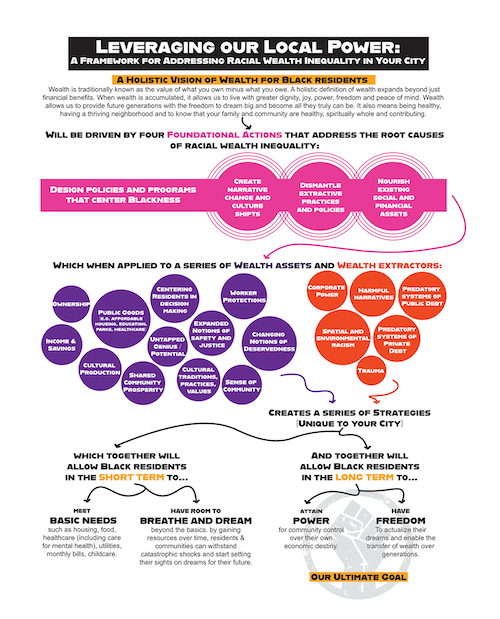
An overview of The Maven Collaborative's framework
With input from our different partnerships, we were able to build a five-step framework (see visual above) that acts as a blueprint for how localities can tackle racial wealth inequality, which includes the following components:
-
Defining a holistic definition of wealth for your locality
-
Understanding the foundational actions that need to be taken to address racial wealth inequality including centering Blackness, creating narrative change, nourishing existing Black assets, and dismantling extractive policies
-
Mapping your locality’s wealth assets (e.g. ownership, cultural production) and wealth extractors (e.g. predatory systems of debt)
-
Applying the foundational actions to your locality’s wealth assets/extractors to create structural strategies
-
Determining your group’s short-term and long-term goals in order to prioritize and chart a path for the implementation of strategies
These five steps are a starting point for localities and can be utilized and adapted for the context of a specific location. Through our collaborative process, we also unearthed some best practices for groups to implement each of these framework components, such as when to employ different research tools and methodologies.
This framework allowed our partners to unlearn approaching the problem with status quo thinking. It empowered them to unlock a structural approach when creating strategies for addressing racial wealth inequality in their city.
For example, when we began our work with our partners in Philadelphia, some folks had difficulty thinking beyond solutions that were already available (e.g. homeownership programs and financial coaching). They decided to dedicate over six months as a group to deepen their understanding of the drivers of racial wealth inequality. They also conducted original research, and through over 250 surveys and 40 in-depth interviews, were able to uncover findings to better understand the challenges their Black residents face in building wealth. From this input, they were able to identify that tangled titles, property deeds that list the name of someone other than the apparent owner, are a major wealth extractor for Black Philadelphians that goes unaddressed. By focusing on one impactful wealth extractor, our partners were able to start small but with intention, working on strategies that would address the root of the problem.
While we have made great strides in building this framework for groups to adapt, it is important to note that much of this work is in progress. As city officials and policymakers, we do not yet have many models or examples to reference when thinking about addressing racial wealth disparities at a structural level. While this can feel daunting, this also serves as an opportunity to unlock and inspire — challenging us to embrace our collective imagination and shift the paradigm of how we as a field have approached this work in the past.
Tapping into radical imagination is not a new concept — Black people have used it throughout U.S. history in their fight for equality. Radical imagination is what brought the Black Panther Party’s free breakfast program to light, it is what abolitionists relied on to free Black people from bondage, and it will take radical imagination to honor their legacies to put an end to racial wealth inequality. There is no better way to honor Black history and the fullness of the Black experience than committing as a field to change course in our failing to address racial wealth inequality.

Natasha Hicks is a design and policy consultant based in Los Angeles. As the Reimagining Wealth Fellow at The Maven Collaborative, she applies her housing, policy, and design expertise to Maven’s racial and gender wealth inequality initiatives. A trained urban planner and architect, Natasha is passionate about addressing the root causes of racial and gender inequity embedded within the built environment.



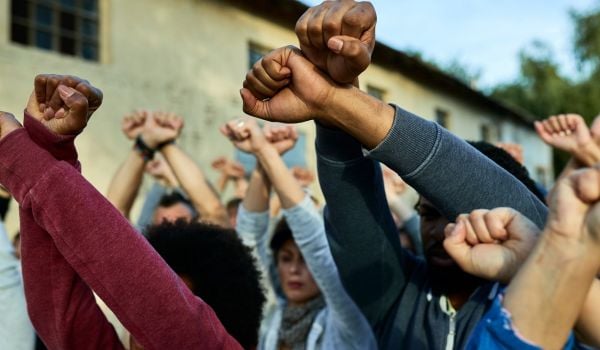
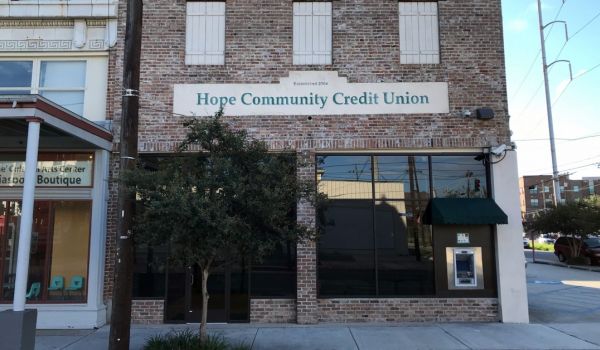
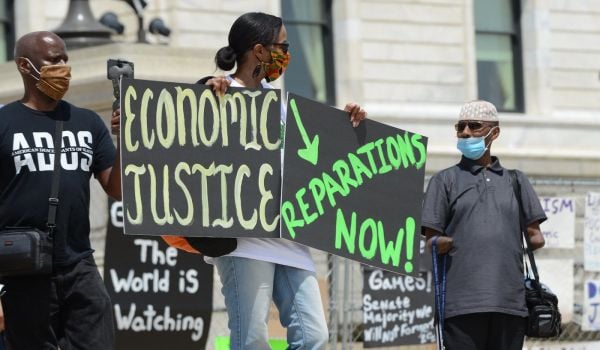
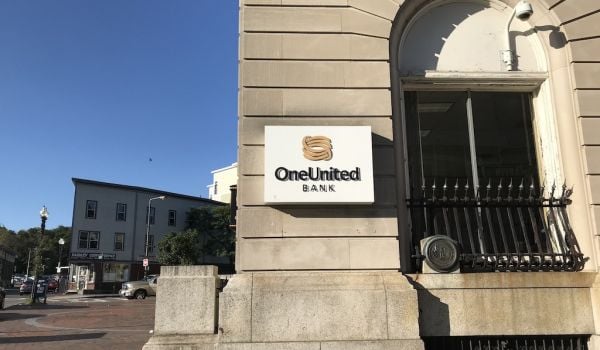

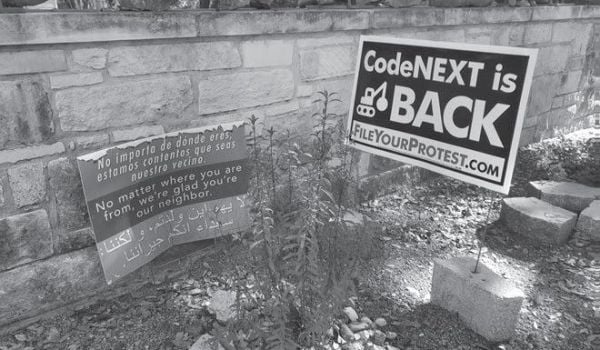








Comment posted on February 27, 2024 at 9:13 p.m.
Ms. Hicks is correct to call on all of us to identify systemic causes of oppression, inequity and poverty. In particular, she asks us to identify “wealth extractors” and remedy them.
Perhaps you’re familiar with the “no good deed goes unpunished” scenario. We identify a distressed community and attempt to improve the lives of residents by improving education, transportation or public safety. And, if we’re successful at any of these endeavors, land prices (and rents) rise. Many of the intended beneficiaries are displaced. Money spent to help the poor ends up enriching landowners (who tend not to be so poor).
Fortunately, some communities are remedying this problem with a Tax Shift. They reduce the property tax rate applied to privately-created building values while increasing the rate applied to publicly-created land values. The lower rate applied to buildings makes them cheaper to construct, improve and maintain over time. Surprisingly, the higher rate applied to land values helps keep land prices more affordable by reducing the profits from land speculation. Thus, without new spending or revenue loss, this Tax Shift can make both buildings and land more affordable. As a bonus, this Tax Shift spurs infill development and new employment opportunities as well.
In addition to successful implementation in about 15 Pennsylvania cities, Detroit’s Mayor Duggan has been moving in this direction that has been endorsed by the StrongTowns movement. For more information, see https://www.shareable.net/land-value-return-and-building-a-more-equitable-economy/ .